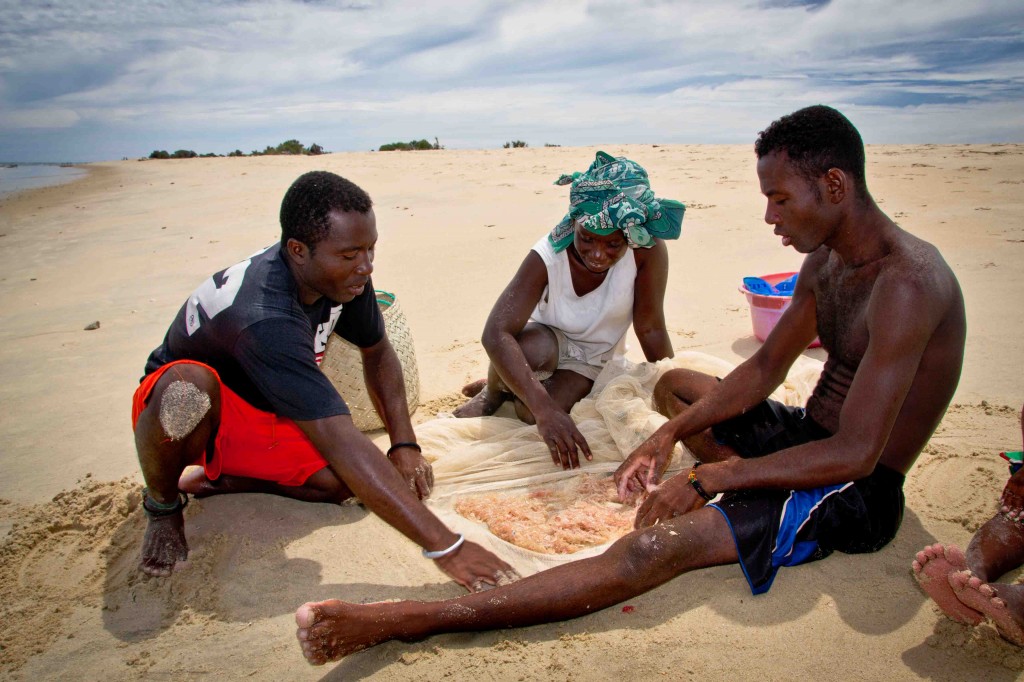By Brian Jones, Belo-sur-Mer Project Coordinator, Madagascar
If the village of Antanimanimbo had a street, they’d be dancing in it. The annual migration of patsa (Acetes erythraeus for you sciency types), a tiny shrimp sometimes referred to as “paste shrimp”, has found its way to this fishing village of a few hundred people in western Madagascar, and in a big way.
“It was a tough year for us here, and this is Zanahary’s* way of saving us,” said Jean-Francois grinning from ear-to-ear during a brief break from the action. And with that he’s back at it, carved features and sinewy frame, etched from a lifetime on the sea, gliding up and down the beach. He sporadically barks orders to his sons about how to position the net around the swarming shrimp and tending to his neatly kept, and ever-growing, pile of slimy crustaceans on the beach.
The patsa have been here for about a week now, with teams bringing in up to 50kg (110lbs) in a day. After being dried, the shrimp fetch around $0.60 per kilo, with local entrepreneurs scrambling to buy up as much as they can for sale in the regional market in Morondava. For these usually subsistence fishers, a good turnout of patsa can bring in more than a month’s earnings in the course of a few days. This rare infusion of cash is often used for big-ticket items like obtaining a new canoe, purchasing some new nets, or mending houses.
No one is left out of the fun, with men, women and children all flocking to the beach to take part in the harvest. Your faithful author declined, citing fear of ruining his expensive camera as an excuse, but the real reason being that I just couldn’t see where the darn things were for the life of me.
Me (hopeless white guy): “Where are they?”
Vezo Fisher: “Right there, you see them?”
HWG (unconvincingly): “Uhh… yeah”
VF (skeptical): “So where are they now?”
HWG (even less convincingly): “Umm… there?” (pointing)
VF (incredulous): “Wow, how are you not seeing them?”
The weapon of choice is a 3-4 meter length of mosquito netting – anything made with a wider mesh would only serve as a speed-bump for the tiny buggers, providing the holders of the net with precious little more than a wet pair of shorts for their troubles. A loop on the bottom corner is hooked around one’s big toe, and the top of the net held by hand as teams of two in chest-deep water, just beyond the breaking waves, work the nets into place, gradually closing them around the swarm and pulling in their prize.
A few weeks ago I was on a site development trip to a small village near Mahajanga, roughly 800km north of Antanimanimbo, where I was speaking with some fishers about what species they catch in their mangroves. They mentioned patsa as well, noting that they tend to catch small amounts here and there throughout the year but that the species was mysteriously absent around the months of February through April. Right around the time they bombard the southwest coast.
Now I’m no marine scientist (as any of the marine scientists who have had the pleasure of working with me will undoubtedly attest to), but could it be that these northern mangroves are the source for this annual migration, making its way down to Toliara in the southwest, covering over 1,200 kilometres of coast?
Researchers and those generally in-the-know on such matters speak much of connectivity, and how “islands” of conservation aren’t sufficient, making the case for networks of Marine Protected Areas, representing all key habitats. The reason they say, is that many important species cover large geographic ranges and utilise multiple habitats throughout their life cycle. A localised reserve may only afford such a species protection for one period in their life cycle. The roving schools of patsa, the Vezo’s proverbial bumper crop and Jean Francois’ new roof, may provide a perfect example of just how true this is.
* Zanahary is the creator in traditional Malagasy beliefs & mythology.





